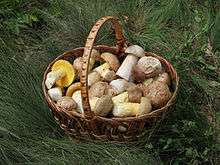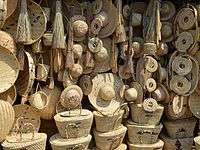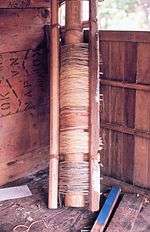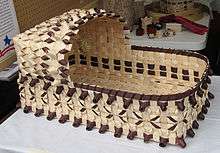Basket
A basket is a container that is traditionally constructed from stiff fibers and can be made from a range of materials, including wood splints, runners, and cane. While most baskets are made from plant materials, other materials such as horsehair, baleen, or metal wire can be used. Baskets are generally woven by hand. Some baskets are fitted with a lid, while others are left open on top.


Uses
Baskets serve utilitarian as well as aesthetic purposes. Some baskets are ceremonial, that is religious, in nature.[1] While baskets are usually used for harvesting, storage and transport,[2] specialized baskets are used as sieves for a variety of purposes, including cooking, processing seeds or grains, tossing gambling pieces, rattles, fans, fish traps, and laundry.
History
Prior to the invention of woven baskets, people used tree bark to make simple containers. These containers could be used to transport gathered food and other items, but crumbled after only a few uses. Weaving strips of bark or other plant material to support the bark containers would be the next step, followed by entirely woven baskets. The last innovation appears to be baskets so tightly woven that they could hold water.
Depending on soil conditions, baskets may or may not be preserved in the archaeological record. Sites in the Middle East show that weaving techniques were used to make mats and possibly also baskets, circa 8000 BCE. Twined baskets date back to 7000 [1] in Oasisamerica. Baskets made with interwoven techniques were common at 3000 BCE.
Baskets were originally designed as multi-purpose vessels to carry and store materials and to keep stray items about the home. The plant life available in a region affects the choice of material, which in turn influences the weaving technique. Rattan and other members of the Arecaceae or palm tree family, the thin grasses of temperate regions, and broad-leaved tropical bromeliads each require a different method of twisting and braiding to be made into a basket. The practice of basket making has evolved into an art. Artistic freedom allows basket makers a wide choice of colors, materials, sizes, patterns, and details.
The carrying of a basket on the head, particularly by rural women, has long been practiced. Representations of this in Ancient Greek art are called Canephorae.
Figurative and literary usage
The phrase "to hell in a handbasket" means to rapidly deteriorate. The origin of this use is unclear. "Basket" is sometimes used as an adjective towards a person who is born out of wedlock.[3] This occurs more commonly in British English. "Basket" also refers to a bulge in a man's crotch.[3]
Materials
Basket makers use a wide range of materials:
Image gallery
 Hand Crafted Woven Basket hanging on the wall.
Hand Crafted Woven Basket hanging on the wall. Four different styles of baskets
Four different styles of baskets- Baskets - Danforth Museum - Framingham, MA
.jpg) A set of traditional hand woven native Indian Nuu-chah-nulth peoples' baskets (Indigenous peoples of the Pacific Northwest Coast of Canada)
A set of traditional hand woven native Indian Nuu-chah-nulth peoples' baskets (Indigenous peoples of the Pacific Northwest Coast of Canada).jpg) Baskets for sale in the island of La Réunion, east of Madagascar
Baskets for sale in the island of La Réunion, east of Madagascar
- Storage basket, Pomo people, (indigenous people of California), Honolulu Museum of Art
- Trinket Basket, Makah people, Northwest Washington, late 19th to early 20th century, twined and plaited bear grass, sedge, cedar bark
- Nootka Makah baskets - Pacific Grove Museum of Natural History
.jpg) Ethiopian woman gathering coffee beans in a basket
Ethiopian woman gathering coffee beans in a basket- Seri Indian pot-shaped basket (Northern Mexico)
 Bending vines for basket construction - Pohnpei
Bending vines for basket construction - Pohnpei

 Yurok baskets from Redwood National Park area, California
Yurok baskets from Redwood National Park area, California Traditional western Hubei baskets (China)
Traditional western Hubei baskets (China)- Backpack made of birch bark.
- Egyptian basket preserved in the Biblioteca Museu Víctor Balaguer, Vilanova i la Geltrú

.jpg) Contemporary bamboo baskets of Bangladesh.
Contemporary bamboo baskets of Bangladesh.
See also
References
- "Hopi Basketry". Northern Arizona Native American Culture Trail. Archived from the original on March 28, 2012. Retrieved Nov 13, 2011.
- "About Baskets". Retrieved April 2, 2019.
- "basket, n." oed.com. Retrieved 18 March 2015.
Sources
- Zepeda, Ofelia (1995). Ocean Power: Poems from the Desert. ISBN 0-8165-1541-7.
External links
| Wikimedia Commons has media related to Basket. |
- . Encyclopædia Britannica. 3 (11th ed.). 1911.
- Baskets, The Women's Committee of the Philadelphia Museum of Art
